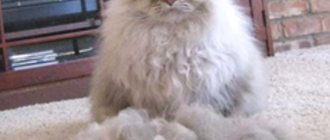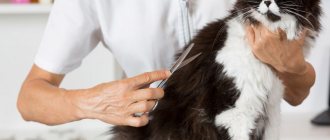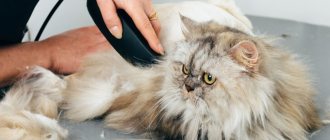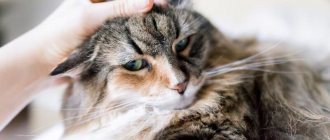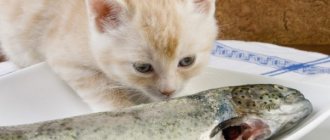Why you shouldn’t pet cats against the grain: facts and myths
To truly understand the essence of the issue, you need to imagine what will be discussed. So, the “culprit” of the rule in question is cat hair. It consists of:
- guard hairs;
- integumentary hairs - are a type of guard hairs, but are stiffer (they, for example, grow along the ridge of an animal);
A cat's fur is made up of different types of hair.
The guard hair is dense, straight, and has pronounced pigmentation, which determines the color of the animal. The hair is thicker at the base and gradually thins towards the end.
The undercoat, or down hair, is very fine. It surrounds the guard hair. Downy wool serves as a kind of air layer and retains heat, partially protecting the cat from slight humidity.
Hair growth direction
The coat has a strict direction of hair growth. This is due to the fact that the ordering of the hairs ensures a tight fit to each other and to the skin. This creates an additional obstacle to heat consumption and partially protects against getting wet.
Guard and cover hairs are the stiffest and have a clear direction of growth.
If you run your palm in the direction of hair growth, the cat will not experience any unpleasant sensations. On the contrary, the pet is pleased, and he may even purr in response to affection.
Cats only enjoy stroking in the direction of fur growth.
When the kitten was small, the mother carefully looked after its fur. This feeling of comfort and security when the cat licked him is firmly imprinted in memory. The owner partly replaces the parent, and stroking reminds of childhood.
Stroking against the grain raises the guard hair. Each hair is surrounded by a large number of nerve endings, which results in severe irritation and possible pain. On downy hair this is not so noticeable due to the fact that it does not have a growth direction, but the spine is more sensitive.
Scientists suggest that when stroking against the grain, the cat experiences sensations similar to those when a person gets “goosebumps” on their back.
Electrification of wool
The outer layer of guard hair is covered with keratin scales. By themselves they are dead, that is, they have no nutrition. The closer the scales adhere to the guard hair, the more shiny the cat’s fur. When stroking against the grain, the fit of the scales is disrupted, they rub against each other and become electrified. Simply put, an electrical charge is formed between the hairs. As a result, the cat simply receives an electric shock (this is not fatal, but quite unpleasant).
An electrical discharge causes trouble not only for the animal, but also for the owner.
Wool is most strongly electrified for three reasons:
- at low air humidity;
- from incorrectly selected shampoo or frequent bathing, which dries out the coat;
- due to poor nutrition.
Static electricity is easily noticeable when a cat is petted in the dark.
Mystical reasons
In ancient times, when people did not yet suspect the existence of electricity, blue lights on wool were associated with witchcraft. The cat has always been considered a mystical animal, and now there is such an incomprehensible phenomenon, accompanied by the glow of the cat’s eyes in the dark. Everything unknown to a person instantly turns into magic. And in order not to invite trouble, in ancient times it was forbidden to stroke a cat against the grain.
What strokes are most pleasant for a cat? (Copy-paste)
All meowing creatures love to be petted. If the animal reacts ambiguously to such manipulations, this means that you are doing something wrong. Meanwhile, there are places on a cat’s body that are the most sensitive, so stroking them gives any cat real pleasure.
You should immediately separate the stroking of the animal owner and the stranger. If a close, beloved owner has access to almost all areas of his tailed body, and touching them brings only pleasure to the cat, then the same touches from someone else will be perceived completely differently.
Why do cats love to be cuddled?
The skin of such animals is very sensitive, since it contains whiskers - hairs of a similar nature to whiskers, but much thinner and smaller; these are organs of touch. If you stroke a cat in the direction of growth of these hairs, it will experience a very pleasant sensation. If you run it against the grain, you will feel discomfort. Cats with short and coarse hair may even experience pain in such situations.
There is another reason why cats love to be petted. In those places from which the animal receives the greatest pleasure from touching, there are glands that exude secretions. Pets use it to mark their territory, objects in the house and, of course, their owners. Therefore, when the owner strokes his pet, he is, as it were, independently “marked” with the pet’s secretion. The animal perceives this situation as special trust from the owner and experiences incredible pleasure from this.
The most sensitive areas on the body
A cat’s favorite places for stroking are the areas where the largest number of so-called “scent” glands are located - those with which cats apply marks, including on their owners. Therefore, the most favorite places are:
1. The area between the eye and ear - the area in cats is a little “bald”, that is, it has thinner hair than on the rest of the body, not only in adult animals, but also in kittens.
It is believed that most of the so-called scent glands are located here - those with which a cat marks “its own”. 2. The middle of the forehead is between the ears. 3. Angle between lips and nose. These are the cheeks themselves - the places where the mustache grows. This is where the cat most often rubs against its owner’s legs and furniture in the house. 4. Chin and lips – the cat likes scratching these places the most. 5. Lower back – at the base of the tail. 6. Belly – there are no glands here with the help of which a cat marks its territory, but a cat’s belly is very sensitive to touch. Only high trust in the owner allows the pet to lie on its back in front of him and allow him to touch his belly. Stroking a stranger
It doesn’t matter whether you are seeing the animal you are about to pet for the first time, or whether you have already been to its house. If the cat does not see you regularly, then he always perceives you as a new person from whom you can expect anything. Therefore, you should not meddle with it right away and unceremoniously smooth it in all places.
Start by holding out your hand to your pet and giving him the opportunity to smell it. By the cat's reaction you will understand whether he doesn't mind being petted. If the animal turns away dissatisfied or does not show any interest in the hand, then you should not touch it. And if he does not remove his head from you and continues to sniff the air, then he expects to be petted.
In this case, touching should start from the head. Start scratching your animal's forehead between the ears with a few fingers. If the cat closes its eyes and again does not remove its head, then you can continue and move towards the neck and ears. Stroke them gently, but do not ruffle or scratch their ears, and do not put too much pressure on your pet's skin.
If the animal arches its back, raising and fluffing its tail, walks back and forth in front of you, and also purrs, then you can not worry and calmly stroke it. If your pet is cowering, sitting in one position and clearly waiting for all this to end, then you shouldn’t continue, he doesn’t like your touch.
Even if the cat does not show aggression, but on the contrary demonstrates a trusting attitude, there is no need to touch its sides and belly without permission. Only if he, having warmed up, falls apart in front of you and exposes his tummy himself, can you pet this place. Otherwise, the pet may even bite you.
If you have access to the belly, you should not touch it too unceremoniously. Be gentle with the cat, do not put pressure on the belly, do not ruffle the fur on it. If at some point while stroking your belly, the cat begins to clasp your hand with its paws and bite it, this means that it doesn’t like something.
Any owner knows which places need to be stroked so that the pet enjoys them, and which areas of the body are better not to touch at all. But even with complete trust with your pet, tactile contact with the cat should be delicate and gradual. Remember, a cat is a very sensitive creature; you should not impose your ideas of tenderness on it.
Petting cats is beneficial!
English doctors claim that a cat in the house reduces the risk of recurrent myocardial infarction. A person who has recently suffered an attack will have their blood pressure and pulse return to normal after petting their beloved cat for a few minutes. Petting cats is also good for digestion. Cats can also relieve fatigue, stress, migraines and lift your mood.
There is a very common belief that cats should never be stroked against the grain. What is the reason for this ban? Any owner knows that it is simply unpleasant for his pet to be scratched in this way. And animals with an aggressive character can even begin to scratch and bite if you start stroking them against the grain. And there is both a completely scientific and mystical explanation for this.
How not to pet cats
To keep the animal happy, when ironing, do not forget about the following rules:
- Do not iron against the grain - this causes discomfort.
- Avoid too rough and sudden movements. Any touches to the cat should be soft and gentle.
- Most cats do not like to have their tummy touched, as this is the most unprotected part of the body: they can only allow a person they completely trust to touch it. Even if they lie down next to you on their back, this is not a reason to stroke their belly - it’s better to scratch under their chin and stroke their chest.
If all these rules are followed, you can hear a contented, grateful purr.
What is cat fur made of?
In order to correctly understand what exactly a cat experiences when it is scratched against its fur, you need to at least know what it consists of. The coat of cats is heterogeneous and includes:
- guard hairs;
- cover hairs, to the touch they are much harsher than guard hairs, despite the fact that they are their variety;
- undercoat (some breeds lack it).
The guard hairs are pigmented, so they determine the color of the cat's coat. At the base, such hair is very thick, but closer to the ends it becomes thinner.
The undercoat, on the other hand, includes very fine downy hair that surrounds the guard hairs. It retains heat well and slightly protects the animal from getting slightly wet.
Hair growth direction
Guard and integumentary hairs grow in a strictly defined direction. Thanks to this, the hairs fit tightly to each other and to the skin. Such orderliness is necessary so that heat exchange is not disturbed, and the cat is at least minimally protected not only from cold, but also from humidity.
Wool is easily electrified
On the outside, the guard hairs are covered with special scales made of keratin; the more tightly they adhere to the hairs, the more shiny and beautiful the pet’s fur is. What happens when you stroke a cat against the grain? The keratin scales move and rub against each other, causing a small electrical charge to form between the hairs. The cat feels this, of course, it is not in danger of a fatal electric shock, but it still becomes quite unpleasant for it. If, after the fur has become electrified, you touch your pet again, a weak electrical charge will hit both you and him. So stroking against the grain brings significant harm not only to the cat, but also to its owner.
What should you do if your pet's fur still becomes electrified, even if you never stroke it against the grain? Most often this happens for three reasons:
- due to low air humidity;
- due to frequent bathing, which dries out the animal’s fur, or due to incorrectly selected shampoo;
- due to poor quality nutrition.
But in any case, strong electrification of the pet’s fur and loss of its shine is a reason to visit the veterinarian. Only he will be able to determine the cause of such symptoms and prescribe the necessary treatment to eliminate them. Remember that dull fur may indicate the presence of diseases, which only a specialist can help you cope with.
A similar sign
Can pregnant women pet cats? To answer this question, we need to consider several points of view. Some associate the ban with superstitions, others justify it as a possible danger to the baby and mother. Scientists have found that even well-groomed pets can transmit diseases. Let's find out what negligence can lead to.
Precautionary measures
To avoid infection, follow these rules:
- Pet only domestic cats. It is strongly recommended to avoid contact with other animals.
- Keep your cat dewormed and vaccinated on time to reduce the risk of your cat becoming infected.
- Do not feed your pet raw meat, eggs or milk.
- Don't let your cat go outside.
- Ask other family members to clean out litter trays.
A cat is not only a cute pet, but also a dangerous predator and a potential carrier of diseases. A pregnant woman is responsible for two lives at once: her own and her child. For this reason, it is better to refrain from contact with street animals, and to carefully treat your pets for parasites and regularly vaccinate them.
Mystical reasons
If you stroke a cat against the grain in the dark, you will notice small blue lights on it. This way you can see static electricity with your own eyes. Previously, people knew nothing about it, so they thought it was a manifestation of black magic. And since the cat has been considered a mystical animal since ancient times, it was strictly forbidden to scratch it against its grain, so as not to invite trouble upon oneself. Our ancestors can be understood, because the eyes of a cat that glow in the dark can scare anyone. And in combination with sparkling fur, they look really unusual, so this phenomenon could well be mistaken for real witchcraft.
As you can see, there are several reasons why it is better not to stroke a cat against its grain. Remember that such stroking is simply unpleasant for your cat, and you still shouldn’t deliberately cause discomfort to her.

